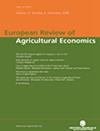集体农业环境计划中的农场协调:有条件激励的作用
IF 3.5
2区 经济学
Q2 AGRICULTURAL ECONOMICS & POLICY
引用次数: 0
摘要
本文分析了法国阿尔萨斯一项新的集体农业环境计划(cAES)的数据,该计划旨在通过激励农民参与栖息地保护措施来保护当地的欧洲仓鼠种群。与根据农民个人表现向其支付报酬的典型保护合同不同,这里研究的cAES只有在集体区域内所有农民保护的土地比例达到临界阈值时才向农民支付报酬。我们发现,集体区域内农业面积相对较大的农民参与的可能性更高,随着集体区域内农民人数的增加而增加,并随着时间的推移而增加。那些在集体区拥有更多土地的人会分配更多的土地用于保护。我们定义了不同的贡献者类型,并深入了解了集体保护计划的潜在贡献动机。本文章由计算机程序翻译,如有差异,请以英文原文为准。
Coordinating Farms in Collective Agri-Environmental Schemes: the Role of Conditional Incentives
This paper analyses data from a novel collective agri-environmental scheme (cAES) in Alsace, France, designed to protect the local European hamster population by motivating farmers to engage in habitat conservation measures. In contrast to typical conservation contracts that pay individual farmers based on their own performance, the cAES studied here pays farmers only when the percentage of land conserved by all farmers within a collective zone reaches a critical threshold. We find that the likelihood of participation is higher for farmers with a relatively large agricultural surface within the collective zone, increases with the number of farmers in a collective zone, and increases over time. Those with more land in the collective zone allocate more acreage to conservation. We define different contributor types and provide insight into the possible motives underlying contributions to collective conservation schemes.
求助全文
通过发布文献求助,成功后即可免费获取论文全文。
去求助
来源期刊

European Review of Agricultural Economics
管理科学-农业经济与政策
CiteScore
6.60
自引率
5.90%
发文量
25
审稿时长
>24 weeks
期刊介绍:
The European Review of Agricultural Economics serves as a forum for innovative theoretical and applied agricultural economics research.
The ERAE strives for balanced coverage of economic issues within the broad subject matter of agricultural and food production, consumption and trade, rural development, and resource use and conservation. Topics of specific interest include multiple roles of agriculture; trade and development; industrial organisation of the food sector; institutional dynamics; consumer behaviour; sustainable resource use; bioenergy; agricultural, agri-environmental and rural policy; specific European issues.
Methodological articles are welcome. All published papers are at least double peer reviewed and must show originality and innovation. The ERAE also publishes book reviews.
 求助内容:
求助内容: 应助结果提醒方式:
应助结果提醒方式:


